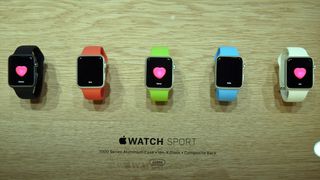Not on my watch: are businesses ready for wearable apps?
Can smartwatches be business tools?

In spite of all the media attention that came with the Apple Watch launch last month, business adoption of wearable tech is still niche. IDC anticipates only 111.8 million wearable tech units worldwide by 2018.
However, business adoption of wearable devices offers obvious benefits for field service efficiency and lone worker safety by allowing employees to receive information and provide live feedback on their health and safety status, while leaving their hands free to work.
A combination of BYOD and major players offering supporting apps will rapidly accelerate business adoption of wearables. For example, in June Salesforce.com launched Salesforce Wear, its developer pack to aid the creation of business apps for wearable devices including the Pebble Smartwatch, Samsung Gear S, the Myo gesture controlled armband and Google Glass.
The preceding month, Water utility company, Severn Trent, announced that its field service engineers are trialling Google Glass and predicted that engineers will be using wearables by 2020.
Wearables explosion
While we're in the early adoption phase at present, I do believe that wearables will become the norm in business. However, I think it's going to be a while before Apple Watch will be used in true enterprise-grade applications with backend data connections.
- Check out our Apple Pay hands-on review
We regularly speak to CIOs and mobile application developers and the reality is that organisations are still struggling with building, deploying and managing apps for smartphones and tablets. Until they get on top of this, many of them may be reluctant to trust their data to a wristwatch for reasons of security and compliance.
Simply does it
That said, the use of simpler apps, such as mapping, will work well in the early adoption phase, because they lend themselves really well to the wearable. In fact a mapping app was demonstrated on the Apple Watch at the launch event in September.
Are you a pro? Subscribe to our newsletter
Sign up to the TechRadar Pro newsletter to get all the top news, opinion, features and guidance your business needs to succeed!
From a business app developer's viewpoint, the Apple Watch has its own set of APIs and software development kits that developers will need to learn. Apple Watch will reach the market in early 2015, so they have around six months or so to prepare.
The dial on the side replaces some of the gestures and swipes that we are used to, so this will have to be factored in to the development of apps. The main frustration will be for developers whose apps will have to support different screen sizes from the iPhone 4S all the way up to iPhone 6 Plus, and down to the tiny Apple Watch display.
Some of the more complex business applications, such as file, document and image analysis, will be out of the domain of the Apple Watch for now, purely because of size of the screen and the fact that it is worn, so data entry is one-handed.
This would preclude the smartwatch from replacing mobile devices currently used for data entry and forms-based processes such as patient records and field service operations, for example. Also, the early challenge will be incorporating and managing data security around BYOW (bring your own watch), just as we had for BYOD.
Security controls
Businesses need to be prepared for wearable devices and to put the relevant security policies and controls in place. From our point of view, the devices that employees select are less important than the information that they process, and that involves managing the lifecycle of the apps end-to-end.
When organisations use an end-to-end mobile application platform (MAP) to support their mobile app strategy, employees gain the freedom to select the right devices to suit their roles, whether they are handheld or wearable, without sacrificing any app functionality. MAPs securely link enterprise backend systems with mobile apps that can support multiple operating systems and various device form factors.
Meanwhile, businesses gain the ability to plan their mobile app strategies to support current and future devices, without having to redevelop apps for every new batch of devices.
- Cathal McGloin is CEO of cloud-based mobile app platform provider, FeedHenry.
Most Popular
